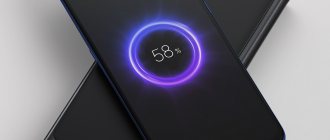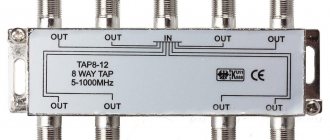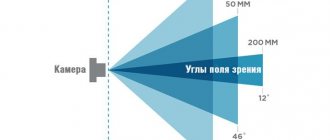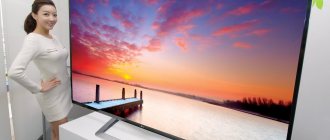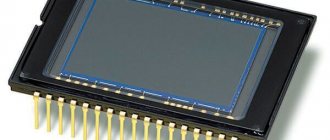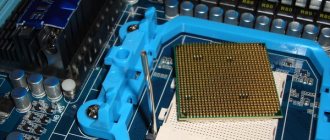The high quality images of modern TVs are made possible thanks to LED backlighting. A new type of backlight has made a real revolution in the field of electronics.
Thanks to new technologies, color quality and image brightness have significantly improved. TV manufacturers currently use 2 types of backlights - direct led or edge led.
Each type has its own pros and cons, so before purchasing you need to decide on the required lighting.
Advantages and disadvantages of LED backlighting
Before the advent of LED backlighting, the type CCFL (Cold Cathode Fluorescent Lamps) was used - fluorescent lamps. They did not allow deep black tones to be realized, it was difficult to create a high-quality color range, and the service life of the lamps was limited. In addition, fluorescent light bulbs contained mercury, which is not environmentally friendly and causes problems during disposal.
Modern LED TV is a representative of liquid crystal panels. The LED backlight of the TV is based on light-emitting white or multi-colored diodes. Based on the color of the light sources, the following are distinguished:
- single-color system (white LEDs);
- multi-color system (RGB);
- a mixed version of QD Vision - when quantum dots of green and red colors are introduced onto blue LEDs.
LED technology has its advantages:
- good efficiency;
- reducing the thickness of the TV screen;
- stylish appearance of the device;
- long service life;
- environmentally friendly due to the absence of mercury and other harmful components in LEDs;
- possibility of point control of groups of diodes.
Disadvantages of LED backlight:
- unevenness – eventually spot darkening of the image may appear;
- does not provide a high-quality viewing angle of the LCD screen;
- the high price of TVs with this technology.
LED lighting is also divided into 2 types according to the method of placement - carpet (direct led) and edge (edge led). They differ in the ways of placing emitting diodes and their number.
LED lighting OLED 4K
Finally, we come to OLED TV lighting. You probably noticed the use of the term “lighting” instead of “backlight”. This is true because 4K OLED TVs do not have a backlight built into them. In OLED panels, each individual pixel on the TV screen (out of 8.29 million 4K UHD OLED TV screens) has its own miniature organic light-emitting diode (OLED), responsible for its own backlight. We can say that this is a backlight in the form of self-illuminating pixels. And now each pixel on the TV can be turned on and off individually to light or dim.
This means no LED-filled backlight panels, no actual LCD surface, and no local dimming zones. Instead, we have 8.29 million local dimming zones on a 4K OLED Ultra HD TV screen. Obviously, this means that an OLED TV can create precise levels of local brightness and dimming that a regular 4K LED TV can't even come close to.
Additionally, because the OLEDs within each pixel produce their own light and can be completely and individually turned off, an OLED TV can produce perfect global black levels with absolutely no backlight leaking through the LCD panel, as is the case with even the best 4K LCD TVs in today's market.
Finally, because they are made without the bulky LED array behind the LCD, OLED TVs offer ridiculously thin displays, with panels on the flagship LG G6 OLED 4K TV and LG OLED E6 models measuring approximately 2.57mm thick. So what should you choose?
Types of ice backlight
Edge lighting, also known as edge led or side lighting - in it, the emitters are located along the edges of the matrix, usually on the left and right sides. The emitted light hits the diffuser and is then scattered. The use of edge technology makes it possible to make a thin TV body, but there will be increased demands on the accuracy of the placement of diodes. If the arrangement is violated, glare will appear on the screen.
Carpet lighting (Full HD LED, LED Pro, Direct LED) – diodes are installed directly behind the matrix. With this technology, illumination uniformity increases and segmented control of LED blocks can be used.
What will happen in the future with OLED and LED?
Manufacturers of LCD displays are trying and will try to “pump up” their devices as much as possible in order to get closer to OLED. While OLED developers, already one step ahead of LED screens, will improve the technology in order to reduce the cost of their devices and increase their durability, so that they can subsequently cover as wide a range of “wallets” as possible.
Samsung has been developing a quantum dot display, QLED technology, for several years. In 2017, these TVs appeared on store shelves. This LED screen promised to be quite close to the quality of OLED, but at the same time have a much reasonable cost. But in reality it turned out that the cost of such TVs is, to put it mildly, unacceptable.
Composite LEDs
The screen backlight is created by standard LED components with appropriate current, voltage and power values. The last parameter determines the luminous flux, which is formed by a certain model of LED elements, and the efficiency of the system.
Direct lighting differs from classic RGB. Tri-color LEDs were supposed to improve the color gamut, but this did not work out as there might not be enough color. Therefore, engineers developed other light-emitting diodes to achieve the desired result. The technology currently uses quantum dots or GB-R and RB-G LED diodes. They differ in that in the first case, the blue and green LEDs are combined into one and covered with a red phosphor, and in the second case, red and blue are combined and covered with a green phosphor.
Edge LED backlighting uses small white light-emitting diodes. Each component is responsible for illuminating a specific part of the screen.
And where are they, all these OLEDs?
It turns out that OLED displays are incredibly difficult to manufacture, which has made them very expensive. Samsung at one time developed one model of OLED TV (KE55S9C) and sold this device for $7,000 in 2013, about the same price as the EA9800 TV from LG. And neither of them were 4K, both TVs only supported Full HD.
Samsung KE55S9C, a TV that cost $7,000 in 2013
Much water has passed under the bridge since then: Samsung decided not to invest money in the further development of OLED displays, while LG decided to continue working with OLED, investing huge amounts of money in the development of this technology. It was a risky move, but their investment paid off, and LG now has an absolute monopoly in the OLED market.
Yes, the prices for such TVs are still quite high, but now you can buy an OLED TV with a 55'' screen for about $1,800, which is not inferior in its characteristics to many premium LED TVs.
Some market giants such as Panasonic, Sony and Philips are slowly entering the fight for OLED TV buyers, using LG panels.
Samsung, in turn, resolutely continues to stick to its line. The company had huge success with its LED screens, and continues to sell LCD TVs in the same vein, arguing that the company can offer high technology for less money than OLED competitors.
You can buy a good 4K LED TV for $500
The low cost of LCD displays is what made 4K TVs so affordable in a relatively short time. Now you can buy a decent 4K TV for $500, and it will be 100% LCD. Will OLED ever be this affordable? Perhaps, but not in the near future.
Features of edge LED backlight
When using edge led backlight technology, all emitting white diodes are placed on the sides of the screen on a metal substrate. The substrate itself is attached to a part of the matrix that acts as a heat sink. If one of the elements breaks, it is difficult to replace, so you will have to replace the entire bar. This type of backlight is used quite often, as it becomes possible to make ultra-thin TVs.
Important! The lateral placement of LEDs allows for high efficiency. Models with side lighting are more expensive than Direct LED due to the presence of a special reflective surface in the design. It is needed to evenly distribute the backlight and reduce brightness differences.
The maximum brightness level is located around the perimeter of the monitor, so backlighting is possible. They will be especially noticeable in a dark picture. The degree of image illumination is different for each model, so you can find a device with minimal changes in brightness.
OLED vs LED: Viewing Angles
OLED has excellent viewing angles primarily due to the thin design of the screen housing itself and the fact that the pixels are very close to the surface. But I can’t say that LED screens have much worse visibility, or simply worse.
Right now I’m looking at my LED monitor from a very sharp angle and I see absolutely everything that is on the screen. But, excuse me, my monitor is already seven years old! And it's not expensive. This is what I mean: with the viewing angle, things are excellent for both OLED and LED, unless, of course, it is not quite a budget (well, very budget) LCD display made of nematic liquid crystals.
One of LG's OLED TVs with a curved screen
There is also such a thing - OLED TVs all have curved screens, which makes it quite difficult to adequately consider viewing angles.
Direct LED backlight
In Direct LED matrix technology, diodes are placed over the entire area of the matrix. This arrangement allows for uniform illumination of the entire surface of the screen. To increase uniformity, a diffuser is additionally installed between the monitor and the diodes.
The placement form, type of diodes and their quantity are chosen by the manufacturer. Due to the need for space for the LED block, the thickness of the TV will be greater than that of a model made with edge LED backlighting.
Local dimming is used to increase static and dynamic image contrast. Dynamic contrast means the ability to control the glow of each diode separately from other sections. It works according to the following principle - the backlight is divided into areas, each of which is controlled by the processor separately. The most expensive models use the most complex dimming algorithm - each area is divided into even smaller areas in which the LEDs increase or decrease their intensity depending on the type of picture. This allows you to achieve the best image.
Can LED compare to OLED?
Just not in contrast. LED screens will never be able to compete with OLED in black levels. No amount of dynamic contrast or local dimming will produce a complete absence of light in a pixel, as OLED can do. On the other hand, LED displays are typically a couple times brighter than OLED - 2000 nits versus 800 nits (currently).
Thus, it turns out that OLED will look best in a darker room, while LED, due to its brightness, feels great in a well-lit room.
Otherwise, LED has a number of advantages that allow it to remain a leader in the consumer market. I wrote briefly about them at the beginning of this article.
Pros and cons of each type
The advantages of Direct LED include the following factors:
- the light field is evenly distributed over the entire area of the matrix;
- the glow is uniform, there are no glares;
- low energy consumption;
- lower cost compared to edge led;
- possibility of repair due to the presence of LED blocks on the rear panel.
The disadvantages of Direct include the thicker body and lower brightness compared to edge-lit screens.
Advantages of edge led:
- increased brightness of the matrix has a positive effect on image perception;
- high contrast;
- stylish design;
- thin display matrix, thin body.
The disadvantages of this technology include the complexity of repairs, the appearance of illuminated areas and higher energy consumption.
What is better to choose
Direct led or edge led – which is better to choose depends on various parameters, which include the individual wishes of the buyer and the conditions of placement and operation. Here are some tips for choosing a TV:
- It is better to install a thin case with edge LED on flat walls;
- if the screen will be placed in a suspended or inclined state, it is better to buy direct ice to avoid deformation of the light diffuser;
- edge ice have higher brightness than carpet type devices.
Important! When purchasing an edge led TV, the image quality must be checked directly in the store. The exposed parts will be visible on the blue screen.
Which backlight to choose, on what factors it depends
To make a decision, you need to take into account the conditions of use, the location of the TV or monitor, as well as several additional recommendations:
- Options with a thin body are suitable for limited space, as well as for direct wall mounting. This type is used where thickness matters and it is advisable to choose a thinner model.
- If the TV will be placed on a bracket at an angle, it is better to choose products with direct backlighting. The fact is that over time the case may become slightly deformed, which, with side illumination, will lead to disruption of the normal illumination of the matrix.
- When choosing an option with side-mounted diodes, it is worth checking the screen for glare before purchasing. It is best to turn on the blue color, as any problems are most visible on it.
It is better to give preference only to well-known companies with a good reputation.
At the end of the video, it will help you choose the right lighting.
Choosing the type of LED backlight in a TV or monitor is not difficult if you understand the features of each option and take into account the nature of use of the equipment. The main thing is to purchase equipment from well-known manufacturers; this is the only way to guarantee that the declared characteristics will not differ from the actual ones.
Main conclusions
Modern TVs use LED backlighting. It is highly efficient, allows you to reduce the width of the body, is environmentally friendly and looks stylish. There are two types of LED backlighting – direct or edge. Differences in types lie in different arrangement of blocks, number and type of LEDs. In direct ice technology, LEDs are placed throughout the matrix, and in edge - on the sides. Which direct led or edge led backlight is better is determined by the user's requirements and conditions of use.
Previous
Lamps and luminairesChoosing the best LEDs for a flashlight
Next
Lamps and fixturesProcedure and diagram for replacing fluorescent lamps with LED lamps

